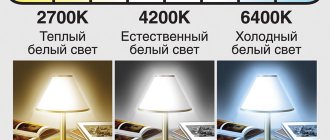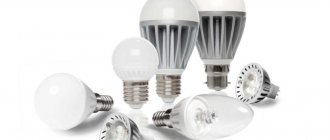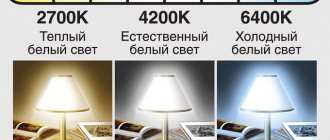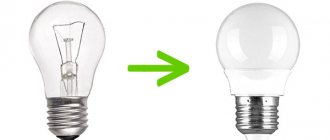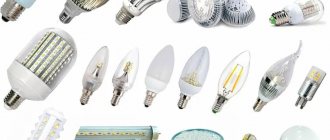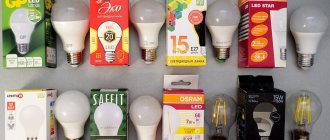In this article we will talk about color temperature and look at the table of LED lamp parameters. You can find this parameter on many lamps and you need to pay attention to it.
Color temperature indicates the wavelength that can be emitted by an element that illuminates a room. It is measured in Kelvin.
Our eyes can see radiation in the range of 800-25000 K, and each of them is perceived differently. Next we will talk about this and what kind of lighting is better perceived by our visual organs. We will also consider what light temperature is best for a particular room.
Concept of color temperature
Color temperature is the most important characteristic of LED electric lighting products. It determines how comfortable you will feel in the interior illuminated by LED lamps, strips or lamps.
New cars are equipped with LED lamps, houses, business premises and outdoor advertising stands are illuminated. They are used in spotlights, street and office lamps, as well as in many other human inventions.
The concept of color temperature of LED lamps does not even imply the amount of heat they give off, but has a completely different meaning. This is the visual effect of the perception of a light source by the human eye. As the color spectrum of light approaches the sun (yellow), the “warmth” of each lamp is determined.
You can also make an association with a candle flame, and you will immediately understand how this phenomenon is described. On the contrary, a bluish tint of light is associated with a cloudy sky and snowy night glow. This light evokes cold, pale images in us. But there is a definite scientific explanation for everything.
When a piece of metal is heated, it develops a characteristic glow. First the color range is in red tones. As the temperature rises, the color spectrum gradually begins to shift towards yellow, white, bright blue and violet.
Conventionally, we have the following table of color temperature of LED lamps:
Each color of metal glow has its own temperature range, which makes it possible to describe the phenomenon using known physical quantities. This helps to characterize color temperature not as a randomly taken value, but as a certain heating period until the required spectrum color is obtained.
The color spectrum of LED crystals is somewhat different. It is different from the possible colors of metal glow due to a different method of its origin. But the general idea remains the same: to obtain the selected shade you will need a certain color temperature.
It is worth noting that this indicator is in no way related to the amount of heat generated by the lighting fixture.
Color temperature is measured in degrees Kelvin (K).
- According to European standards, all light sources are divided into three groups based on color:
- warm white (Tc = below 3500 K)
- neutral white or daylight (Tc = 3500-5300 K)
- cool white (TC = above 5300 K)
The color temperature of a conventional incandescent lamp is approximately 2800 K, so the warm-white light of LED lamps is most familiar to the eye (from 2700 to 3500 K).
For most types of work and premises, “neutral” light sources (Tcv = 4000-4500 K) are recommended. If we talk about the influence of color temperature on a person, then warm light relaxes and creates an atmosphere of comfort, and cooler tones help the body concentrate and set the mood for work.
Once again, I want to note that you should not confuse the color temperature and the physical temperature (amount of heat) that your lamp emits - these are different indicators.
By combining lighting sources with different temperatures within one room, you can change the color perception of objects in the interior. But don't get carried away! It is important to ensure the harmony of colors, otherwise you may end up with a “color disco” that will irritate your eyes. And an unsuccessful decision will show the taste of the apartment owner is not from the best side.
- The red color can be softened by a warm orange tint of light (2500-3000 K).
- The orange color (intense) is transformed into a soft and pastel color with the help of a warm yellowish tint (3000-4000 K).
- The yellow color will become gray and inexpressive if you use lamps with a bluish tint (5000-6500 K).
- The green color can be softened to light green using warm orange light or given a sea green hue using bright bluish light.
- The blue color can be most adequately conveyed by light sources of a neutral white hue.
- The violet color will turn into red under a yellowish tint of lighting, so it is illuminated with high color temperatures.
By making a mistake when choosing a lamp of a certain color temperature, you can significantly change the color perception of the interior. Our eyes distinguish about 10 million different shades, so lighting directly determines how we perceive the color of interior items.
What is measured in Kelvin
This concept relates to physics. Scientists have long established that each color has its own “temperature,” which is measured in Kelvin (K). This parameter is indicated on lamp packaging. Absolutely black color (black body) has zero color temperature (0 Kelvin).
- The dark red hue will take on a completely black body if it is heated to a temperature of 800 K (which corresponds to 527 ° C).
- Bright red color corresponds to a temperature of 1300 K (or 1027 ° C). In real life, this phenomenon can be observed when heating some metals.
- Orange color – 2000 K (or 1727°C). This light comes from a candle or hot coals.
- Yellow color – 2500 K (or 2227°C). It can be seen at sunrise.
- White color – 5500 K (or 5227°C). It matches the color of the sun at noon.
- Blue color – 9000 K (or 8727°C). This is the color of a thermonuclear reaction, which is almost impossible to see in life.
As we see, in fact, those colors that are considered “cold” in everyday life (white, blue) are obtained from the hottest bodies. It is worth noting that the lamps do not heat up to such temperatures, and the value in Kelvin is a comparative conditional indicator.
How does it work in everyday life?
This temperature principle works in the production of light sources and their selection for use in interiors. All lamps have a certain temperature.
When choosing light sources, you need to know what temperature corresponds to a particular shade. For some areas in the interior, designers recommend using lamps of the appropriate color temperature.
| Color temperature, K | Hue | Application |
| 2500–3000 | Warm orange | Cozy evening atmosphere in the bedroom, living room. Dining table lighting. Floor lamps, sconces, bedside lamps. |
| 3000–4000 | Warm yellowish | Comfortable and relaxing light for living rooms. Most often, this temperature is used in chandelier lamps and wall lamps. |
| 4000–5000 | Neutral white | Daylight for living rooms, kitchens, office workstations, reading corners. Suitable for ceiling and pendant lights. |
| 5000–6500 | Bluish | This color temperature is not used in the home. Most often used in jewelry stores and museums. |
For certain areas in a house or apartment, as well as for specific situations (for a living room - receiving guests, a romantic dinner, etc.), light sources with the most comfortable shade and appropriate color temperature are selected.
Giving off heat
Any object in the world around us has a temperature above absolute zero, which means it emits thermal radiation. Even ice, which has a negative temperature, is a source of thermal radiation. It's hard to believe, but it's true. In nature, the temperature of -89°C is not the lowest; even lower temperatures can be achieved, however, for now, in laboratory conditions. The lowest temperature that is currently theoretically possible within our universe is the temperature of absolute zero and it is equal to -273.15 ° C. At this temperature, the movement of the molecules of the substance stops and the body completely stops emitting any radiation (thermal, ultraviolet, and even more so visible). Complete darkness, no life, no warmth. Some of you may know that color temperature is measured in Kelvin. Anyone who bought energy-saving light bulbs for their home saw the inscription on the packaging: 2700K or 3500K or 4500K. This is precisely the color temperature of the light emitted by the light bulb. But why is it measured in Kelvin, and what does Kelvin mean? This unit of measurement was proposed in 1848. William Thomson (aka Lord Kelvin) and officially approved in the International System of Units. In physics and sciences directly related to physics, thermodynamic temperature is measured in Kelvin. The beginning of the temperature scale report
begins at the point
0 Kelvin
, which means
-273.15 degrees Celsius
.
That is 0K
is
the absolute zero temperature
. You can easily convert temperature from Celsius to Kelvin. To do this, you just need to add the number 273. For example, 0°C is 273K, then 1°C is 274K, by analogy, a human body temperature of 36.6°C is 36.6 + 273.15 = 309.75K. That's how it all works out just like that.
Color temperature scale
Today's domestic market offers a huge range of light sources based on LED crystals. They all operate in different temperature ranges.
Usually they are chosen depending on the location of the intended installation, because each such lamp creates its own, individual look. The same room can be significantly transformed by changing only the color of the lighting.
For optimal use of each LED light source, you should decide in advance which color is most convenient for you. The concept of color temperature is not specifically related to LED lamps, it cannot be tied to a specific source, it depends only on the spectral composition of the selected radiation.
Each lighting device has always had a color temperature, it’s just that when standard incandescent lamps were released, their glow was only “warm” yellow (the emission spectrum was standard).
With the advent of fluorescent and halogen lighting sources, white “cold” light came into use. LED lamps are characterized by an even wider range of colors, due to which the independent choice of optimal lighting has become more complicated, and all its shades began to be determined by the material from which the semiconductor was made.
Color rendering index of LED lamps
The color rendering index characterizes the ability to perceive color gradations. When the light temperature of LED lamps is below 3200 K, color perception is significantly reduced. Try pulling out a green or brown color from a box of colored pencils by candlelight. Believe me, the task will not be easy.
The color rendering index is very clearly regulated for automotive LED lamps, because if color rendering is poor, a situation may arise when the driver cannot distinguish between the road surface and the side of the road.
Light can change the brightness and saturation of colors in a room. This phenomenon is called metamerism.
Each lamp has a certain color rendering, which is indicated on the packaging by the Ra (or CRl) index. This source parameter is determined by its ability to accurately convey the colors of the illuminated object.
You will achieve the best results by using lamps with a color rendering index of 80 Ra and higher. This will allow all interior colors to look most natural.
| Characteristic | Coefficient | Examples of lamps |
| Reference | 99–100 | Incandescent lamps, halogen lamps |
| Very good | More than 90 | Fluorescent lamps with a five-component phosphor, MGL lamps (metal halide), modern LED lamps |
| Very good | 80–89 | Fluorescent lamps with three-component phosphor, LED lamps |
| good | 70–79 | Fluorescent lamps LBC, LDC, LED lamps |
| good | 60–69 | Fluorescent lamps LD, LB, LED lamps |
| Mediocre | 40–59 | DRL lamps (mercury), NLVD with improved color rendering |
| Bad | Less than 39 | HPS lamps (sodium) |
Different types of lamps, while having the same color temperature, can render colors differently. The color rendering index determines the degree of deviation of the color of interior items from its real color when illuminated by a particular lamp.
Flask
Which lamps are better - with a matte or transparent bulb? The LED is a point and very bright light source. If the lamp is visible in a chandelier or lamp, for example it is directed downward, then with a transparent bulb an irritating effect may occur, similar to a welding arc.
However, the matte diffuser does not have this drawback. Decide what is best for you - even, soft and diffused light, or very bright.
An exception is crystal chandeliers and similar lamps.
For them, point and sparkling light sources are better, which give a play of light on the edges of crystal elements.
Color Temperature Marking
On the packaging of each lighting lamp, manufacturers indicate its technical characteristics. Among all other characteristics, such as power, voltage, network frequency, the color temperature of LED lamps must be indicated (this applies not only to LED lamps).
You should definitely pay attention to this main factor before purchasing a lamp.
By the way, this characteristic is displayed not only on the packaging, but also on the lamp itself. Here is one example, an LED lamp with a power of 7 W and a temperature of 4000 K. It is installed in my home, in the kitchen, and shines with pleasant daylight.
And here is another example of the designation on an LED spotlight for plasterboard ceilings, temperature 2800 Kelvin. Lamps with this color temperature shine with a warm light similar to an incandescent lamp and were installed in the bedroom of one of the objects.
Supply voltage
There are lamps that are produced only for 220 volts:
- models with G9 base
- reflector lamps R39, R50, R63, R80
And there are models that are available for both 12 volts and 220V. Moreover, their shapes are almost identical.
- capsule G4
- reflector MR16 with GU 5.3 base
- GX 53 tablets
Relationship between color temperature and lighting
A clear knowledge of the tabular values of this characteristic helps to understand what color will be discussed further. Each of us has a different color perception, so only a few can visually determine the coldness or warmth of the light flux.
The average indicators of a group of products operating in a given spectrum are taken as a basis, and when making the final selection of LED lamps, the specific conditions of their operation (installation location, illuminated space, purpose, etc.) are taken into account.
- Today, all lighting sources, depending on their luminescence range, are classified into three main groups:
- warm white light - work in the temperature range from 2700 K to 3200K. The spectrum of warm white light they emit is very similar to the glow of a conventional incandescent lamp. Lamps with this color temperature are recommended for use in residential areas.
- daylight white light (normal white) – in the range from 3500 K to 5000 K. Their glow is visually associated with morning sunlight. This is a neutral range luminous flux that can be used in apartment technical rooms (hallway, bathroom, toilet), offices, classrooms, production workshops, and so on.
- cool white light (day white) – in the range from 5000 K to 7000 K. Reminiscent of bright daylight. They illuminate hospital buildings, technical laboratories, parks, alleys, parking lots, billboards, etc.
It would seem, why do we need LEDs of warm and cold colors if they are not able to provide normal perception conditions.
One of the main areas of application of LEDs with low color temperature (2400-3000 K) is lighting in a “noisy” optical environment. Simply put, lighting in poor visibility conditions.
Let's take a car headlight. In heavy fog, white light, due to its short wavelength, is reflected from water spray, which significantly limits the visibility range. Yellow light has a wavelength several times longer; it does not reflect from small objects, but bends around them. That's why fog lights in cars are made yellow.
At the same time, short waves propagate further without attenuation. As an analogy, consider radio waves and hard short-wave X-rays.
Even a thin sheet of metal blocks radio waves, and thick lead is used to protect against x-rays. Cool white light is used in long-distance warning systems, floodlights, signal and search lights.
Which lamps to choose for the office
The regulatory document SP 52.13330.2011 “Natural and artificial lighting” recommends the use of various radiation sources depending on their type, power, design and characteristics of the luminous flux.
Residential premises are required to be equipped with small and low-temperature “warm” lighting devices, and in non-residential buildings larger lamps of normal “white” light must be installed.
It has been proven that white lighting is optimal for the work process, since the part of the blue spectrum it contains has a beneficial effect on a person, helps him concentrate, speeds up the reaction and work processes of the body.
It is good to choose radiation sources from 3500 K to 5600 K, with white or neutral light, with a slightly bluish tint. Such lighting will make it possible to increase performance to the maximum level.
Both fluorescent and LED lamps are suitable, although the latter will provide significant savings in energy resources.
On the contrary, it would be a big mistake to install cold white light lamps in such a place with a range close to 6500 K. This will lead to rapid fatigue of workers, complaints of headaches and a sharp decrease in performance.
In the workplace, the color temperature should be as close as possible to the color of natural light.
If with white light and prolonged human work we take its production as 100%, then with yellow light it will be only 93%, with green 92%, with blue 78%, with red and orange 76%. Those. in the workplace, daylight will be more useful (approximately 4000-4500 K).
Which lamps are suitable for home
White light is not recommended in apartments and private houses. It is not necessary to place the same lamps everywhere; it is better to use individual recommendations for lighting equipment in such rooms. Lamps with white neutral light are well suited for lighting the kitchen, bathroom, and will fit into the interior of the hallway. Their temperature can vary from 4000 K to 5000 K.
But for the bedroom, nursery and rooms where you relax, it is preferable to use warm tones of the light spectrum. The best solution here would be warm white light closer to 2700 to 3200 K. It will relieve daytime tension, create comfort and allow you to relax.
It is convenient and effective to use normal white light in the reading area and work corner, as well as to illuminate mirrors in front of which makeup is applied. This way you will achieve maximum color contrast and convenience for the actions performed.
It is better to equip a child’s desk with a lamp with a temperature of 3200-3500 K. It will not create unnecessary eye fatigue, and proximity to the white spectrum will help to get ready and tune in to work. For all LED lamps, their operating temperature is indicated on the packaging.
While our eyes have become accustomed to the soft white color temperature of incandescent bulbs over the years, that doesn't mean they're necessarily the best option for lighting your entire home.
For example, because of their warm color temperature, these soft white lights often draw warm colors from the room (red, orange-colored objects), changing the contrasts throughout the space. Here are some tips on how to most effectively light different rooms in your home:
- Warm white light (2700-3200 K)
Warm light is preferable for recreational areas, that is, places intended for relaxation. Such lamps are installed in bedrooms and living rooms. In the living room it is better to combine neutral and warm light.
If there is insufficient natural light, we turn on neutral or both, and in the evening or when watching TV, turn on warm. For the bedroom, you should definitely opt for warm light lamps.
- Neutral white light (3200-4500 K)
It is preferable to use such lamps in rooms intended for visual work. This radiation spectrum does not tire the eyes and provides the best color perception.
- Cool white light (over 4500K)
As already mentioned, cool white light has a stimulating effect on our brain. In everyday life, it is used in situations where periodic concentration of attention is desirable, for example, examination rooms, operating rooms.
LED lamps with cool white light placed in the bathroom will help you get into working tone faster in the morning.
Color temperature and our emotions
The temperature of light can directly affect a person’s psychological state. Warm orange and yellowish shades are best used for the morning, as they promote a gentle awakening, put you in a positive mood and stimulate activity.
These shades are also good to use in the evening because of their calming effect.
Light sources with neutral white are ideal for rooms where they spend a lot of time and work for a long time. Such shades are most consistent with midday sunlight, so the body perceives such lighting as a signal for vigorous activity.
Lamps with a high color temperature cannot be used for a long time, as they have an extremely stimulating effect on the human psyche. When used short term, this light stimulates the body. And in the long term, the opposite effect is possible - inhibition, depression.
At a low level of illumination (little light), a person feels better in “warm light” (Tcv = 3000 K), and if the illumination is high (>700 lux), then discomfort and pain in the eyes will appear. And vice versa: Tcv = 5000 K - comfortable from 700 lux to 2500 lux, but at illumination less than 150 lux the light will be perceived as alarming (moonlight).
The temperature of the light affects the psychological state of a person, creates a certain atmosphere in the room, activates the body’s work or, on the contrary, relaxes.
Quality
Let's say you have decided on all the above points. How can you tell a high-quality light bulb from a low-quality one?
If the lamps are the same in power and size, do not have pulsation and are very similar in appearance, then its weight can be considered an indirect sign of quality.
Estimate the weight in your hands or compare the data on the packaging. The lamp whose weight is greater is potentially better. More weight is a sign of a more massive cooling radiator.
Better heat dissipation means longer service life. If the product is powerful, but at the same time “weightless,” then this is a clear sign of a short-lived product.
What is color
No matter how strange it may sound, light has its own color temperature! Your apartment, house, office or grocery supermarket across the street has lamps and lighting devices.
And your perception of objects and even your mood depend on what color temperature they have. Let's understand these digital values, how many Kelvins are there for what kind of glow.
- 2700 K – popularly sounds like a warm glow or warm white.
- 4000-4200 K is naturally white, although many consider it a cool white or cool glow, although this temperature is closest to the morning sun and lunchtime sun.
- 5500-6000 K – bright white or close to daylight.
Different types of lamps are used in the interior and exterior, based on the tasks, conditions and personal preferences of the person.
In classic interior design, warm or warm white light (2700 K) is mainly used. LED lamps are ideal for these needs. In the color temperature column, check the “warm glow” box.
For a rapidly developing world, a glow temperature of 4000-4200 K is increasingly suitable, so naturally white light is used in Hi-tech design interiors.
For offices, conference rooms, laboratories and other high-precision work performed indoors, use bright white from 6000 K and above.
Warm light how many Kelvins
Warm orange: 2500–3000 Kelvin - will help create a cozy evening atmosphere in the bedroom and living room. Used in floor lamps, sconces, bedside lamps, and for lighting the dining table. Warm yellowish: 3000–4000 Kelvin – relaxing and comfortable light for living rooms. Typically used in wall and ceiling lamps.
Cold white light how many Kelvins
Cool white - color temperature above 5300 K. If daylight is more appropriate in the workplace (approximately 4000-4500 K), then cooler white light is useful for reading (but only up to 6500 K).
2700 Kelvin what light
The color temperature of a conventional incandescent lamp is approximately 2800 Kelvin, so the warm-white light of LED lamps is most familiar to the eye (from 2700 to 3500 K).
3000 Kelvin what color
The color temperature of yellow is approximately 3000 K - this is a 200 W incandescent halogen lamp.
Color temperature 4000 K – what color is it
4000-4200 K is naturally white, although many consider it a cool white or cool glow, although this temperature is closest to the morning sun and lunchtime sun.
4300 Kelvin color
4300-4500 K – morning sun and lunchtime sun. If we talk about cars, standard xenon, which is installed directly at the factory, has a glow color of 4300 Kelvin. When replacing car lamps in order to maximize the best visibility, experts advise installing xenon with a color of 4300 K.
6000 Kelvin what light
The color of the radiation at 6000 K becomes bluish. This is how a fluorescent lamp with a daylight color of 6000 K shines.
6500 Kelvin what light
6500K is a standard daytime white light source, close to midday sunlight. For the working kitchen area, it is recommended to use cold light bulbs (above 6500 K), such light will invigorate.
Life time
Each manufacturer indicates the service life on the packaging. However, even famous brands do not indicate periods of more than 25,000 hours of operation.
If on average a light bulb shines for 5-6 hours a day, then that’s already more than 10 years!
When the packaging states operating times of 30,000 or 50,000 hours, and the manufacturer’s warranty is only 12 months, then it’s clearly worth thinking about.
Which light is better: warm or cool?
Cold and warm light lamps
Light is usually divided into warm and cold. Warm light is best for the evening, while during the daytime cool light is most natural. Playing an important role in the formation of human circadian rhythms, warm light helps us relax, forget about the worries of the day and prepare for sleep.
Cold weather, on the contrary, keeps us in good shape, makes us more alert and energetic. But both cold and warm light can disrupt our internal clocks, catching us at the wrong time.
The color of light is expressed in color temperature (measured in Kelvin), equal to the temperature of a black body at which it emits radiation of the same color. You may be confused that warm light corresponds to a low temperature, and cold light corresponds to a higher temperature, but, unfortunately, this is exactly the case.
Thus, light with a color temperature of 2700-3000 K is called warm, has a yellowish tint and is typical of incandescent lamps. As their name suggests, they glow due to a hot tungsten filament, the actual temperature of which is directly related to the temperature of the color.
Fluorescent lamps come in both soft white light with a temperature of 3000 K, and with cold light - from 4000 to 6500 K.
During sunrise and sunset, sunlight is slightly warmer than the light of an incandescent lamp - about 1800 K, at noon in clear weather - 6500 K. This is why we associate warm light from artificial sources with the evening, and cold light with a bright sunny day.
It is worth noting that on a cloudy day, diffused sunlight can reach a temperature of 10,000 K, which, along with the absence of visible shadows, has a depressing effect on a person. Fortunately, lamps with such characteristics are practically not found (except among photographers).
At night, the Moon emits a bluish, cold light with a temperature of 4100 K. The light from a match or candle flame usually has a temperature in the range of 1700-1900 K.
In warm lighting, we usually perceive the colors of objects a little differently than in normal daylight. An incandescent lamp, for example, enhances warm tones and mutes cool ones.
You should pay attention to this when purchasing furniture and interior details. To avoid unpleasant surprises, they should be chosen in lighting that is as close as possible to that available in your apartment. Also remember that the color can be affected not only by the characteristics of the lamp itself, but also by lampshades, shades and other diffusers.
As we age, the lenses in our eyes can yellow a little, so we begin to see everything in warmer colors. Adding cool light to your lighting can help in this situation.
Warm or soft white light is great for creating a cozy feeling in living spaces where we want to feel relaxed and comfortable. Too much warm light in the workplace can make you sleepy and prevent you from focusing on the right tasks. That is why office spaces usually have a predominance of lamps with cool light.
Warm light in Kelvin
Warm light relaxes and creates a cozy atmosphere. Warm white: color temperature below 3500 K. It is better to choose the exact color temperature in Kelvin, as it may vary from person to person.
So what's better
Often the best option will be a combination of cool and warm light, as well as the ability to control the lighting fixtures individually to create a specific mood throughout the entire room or part of it.
Thus, you yourself can always get an atmosphere of warmth and comfort using warm-range lighting. Or, conversely, use cold light to solve problems that require attentiveness and concentration.
In the evening, you can turn on the incandescent lamps and light the fireplace to relax and unwind in an atmosphere of warm light. And if you suddenly want to read a book, use a separate lamp that gives a cooler light.
Warm lighting will fit perfectly into a small apartment decorated in a vintage style with a predominance of warm colors in the interior, and cold light will highlight modern design solutions in a spacious room with brightly colored objects and light walls.
Author: Sergey Vladimirovich, electrical engineer. More about the author.

